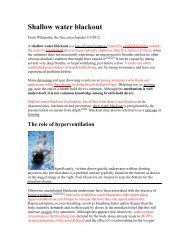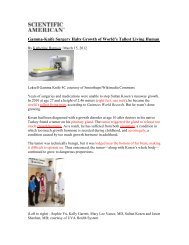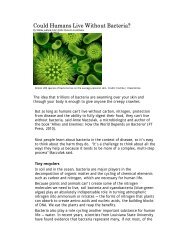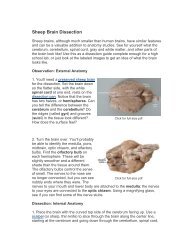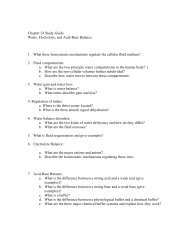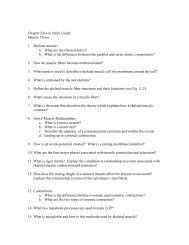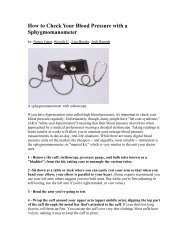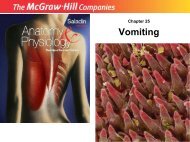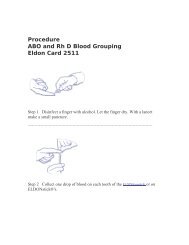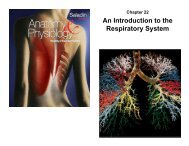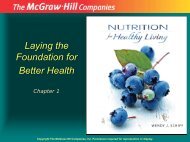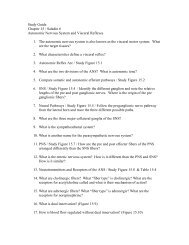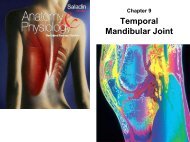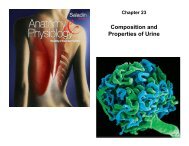Bio 1400 Study Guide Chapter 4 Body Basics 1. What forms the ...
Bio 1400 Study Guide Chapter 4 Body Basics 1. What forms the ...
Bio 1400 Study Guide Chapter 4 Body Basics 1. What forms the ...
- No tags were found...
You also want an ePaper? Increase the reach of your titles
YUMPU automatically turns print PDFs into web optimized ePapers that Google loves.
<strong>Bio</strong> <strong>1400</strong><br />
<strong>Study</strong> <strong>Guide</strong> <strong>Chapter</strong> 4<br />
<strong>Body</strong> <strong>Basics</strong><br />
<strong>1.</strong> <strong>What</strong> <strong>forms</strong> <strong>the</strong> foundation for <strong>the</strong> scientific study of nutrition?<br />
2. <strong>What</strong> may happen when a chemical bond is form?<br />
3. <strong>What</strong> is <strong>the</strong> difference between ammonia and ammonium?<br />
4. <strong>What</strong> is <strong>the</strong> normal blood pH range?<br />
5. Give examples of acid and base house products:<br />
6. <strong>What</strong> type of chemical reaction occurs when you mix baking soda and vinegar? <strong>What</strong><br />
is <strong>the</strong> significance of this reaction when you bake a cake?<br />
7. When reading text, how can you tell if a word describes an enzyme? <strong>What</strong> factors<br />
affect enzymes?<br />
8. Describe a typical cell and define <strong>the</strong> “function” on each component:<br />
9. <strong>What</strong> is <strong>the</strong> structural hierarchy of <strong>the</strong> human body?<br />
10. <strong>What</strong> can disrupt homeostasis?<br />
1<strong>1.</strong> <strong>What</strong> are “11” systems of <strong>the</strong> human body? Explain <strong>the</strong> function of each system:<br />
12. Are vegetable “raw foods” more nutritious than cooked vegetables?<br />
13. <strong>What</strong> are <strong>the</strong> major structures of <strong>the</strong> GI tract? <strong>What</strong> are <strong>the</strong> accessory organs of <strong>the</strong><br />
GI tract?<br />
14. <strong>What</strong> are <strong>the</strong> two <strong>forms</strong> of digestion that occur in <strong>the</strong> mouth? Explain<br />
15. <strong>What</strong> is <strong>the</strong> function of <strong>the</strong> taste buds and where are <strong>the</strong>y located?<br />
16. <strong>What</strong> type of taste can taste buds distinguish?<br />
17. Are <strong>the</strong> number of taste buds constant throughout life?<br />
18. <strong>What</strong> happens when you swallow?<br />
19. How much food can <strong>the</strong> stomach store? How long does it take for <strong>the</strong> stomach to<br />
empty?
20. <strong>What</strong> is <strong>the</strong> chemical environment inside <strong>the</strong> stomach and what prevents <strong>the</strong> stomach<br />
from digesting itself?<br />
2<strong>1.</strong> Are nutrients absorbed in <strong>the</strong> stomach?<br />
22. <strong>What</strong> two structures function as <strong>the</strong> “gate keepers” for <strong>the</strong> stomach? <strong>What</strong> is<br />
heartburn?<br />
23. <strong>What</strong> is <strong>the</strong> relative length of <strong>the</strong> three sections of <strong>the</strong> small intestines?<br />
24. <strong>What</strong> happens in <strong>the</strong> small intestines? How long does it take for <strong>the</strong> chyme to move<br />
through <strong>the</strong> intestines?<br />
25. <strong>What</strong> role does <strong>the</strong> liver play in <strong>the</strong> digestive system?<br />
26. <strong>What</strong> is <strong>the</strong> relationship between <strong>the</strong> liver and gall bladder?<br />
27. <strong>What</strong> is <strong>the</strong> function of <strong>the</strong> pancreas in <strong>the</strong> digestive system?<br />
28. <strong>What</strong> is <strong>the</strong> regulatory mechanism between <strong>the</strong> duodenum, liver, gall bladder, and<br />
pancreas?<br />
29. <strong>What</strong> is <strong>the</strong> function of “absorptive cells of <strong>the</strong> small intestine? <strong>What</strong> is unique about<br />
an infant’s absorptive cells?<br />
30. <strong>What</strong> is <strong>the</strong> relationship between <strong>the</strong> portal vein, chylomicrons, and lacteals?<br />
3<strong>1.</strong> Explain <strong>the</strong> condition and physiologic mechanism associated with <strong>the</strong> following<br />
conditions: cystic fibrosis, inflammatory bowel disease, constipation, diarrhea, vomiting,<br />
heartburn, and peptic ulcer.<br />
32. How long is <strong>the</strong> colon? <strong>What</strong> happens in <strong>the</strong> colon?<br />
33. <strong>What</strong> is <strong>the</strong> terminal section of <strong>the</strong> large intestines called and what is stored here?<br />
34. Are <strong>the</strong>re bacteria in <strong>the</strong> GI tract? Explain



